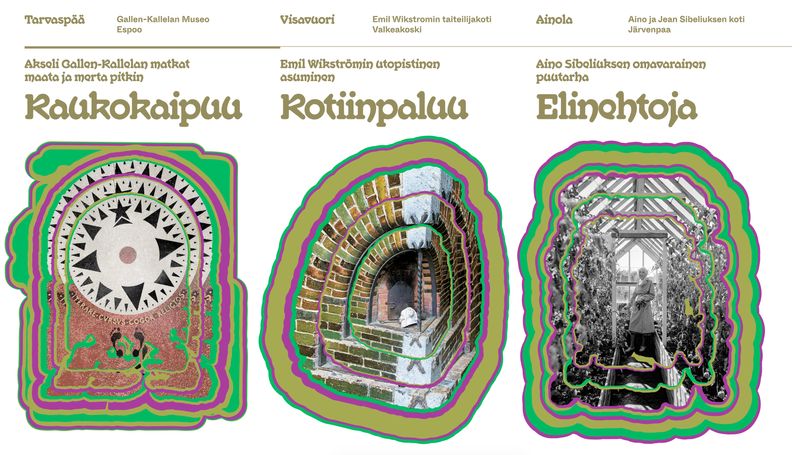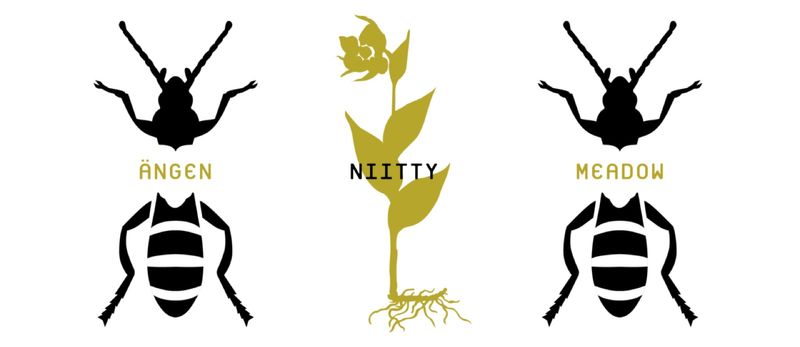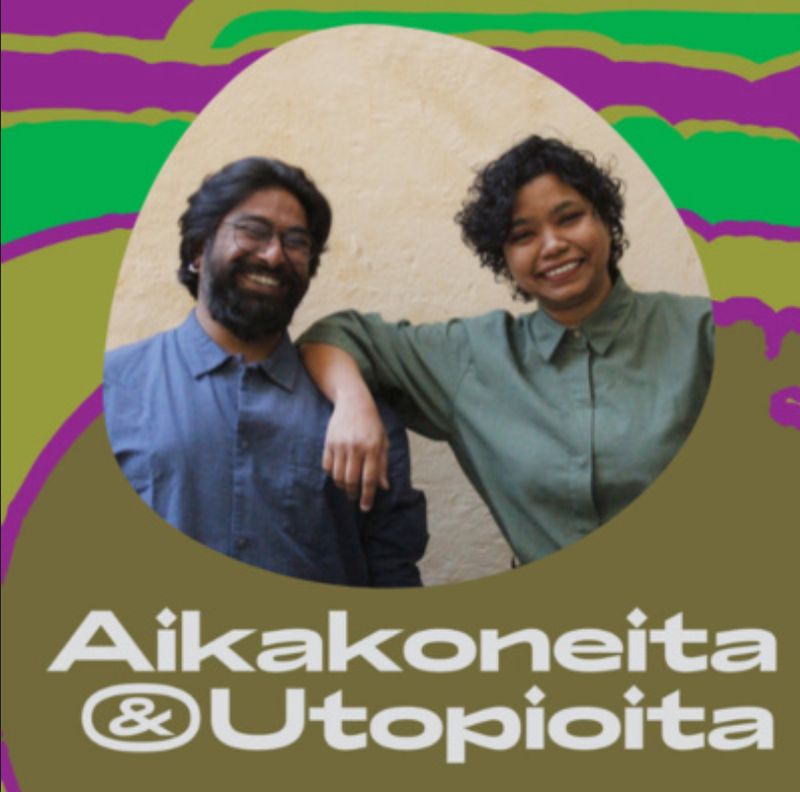
The art of making art seen through the lens of serving and consuming food
by Rosalyn D`Mello, Stir World
- The art of making art seen through the lens of serving and consuming food
- Time Machine and Utopias: Longing, Living conditions, Homecoming
- Artists Vidha Saumya and Ali Akbar Mehta: Recipes come together from resources - and we are not living in the world where everybody have the same resources
- The Meadow
- The art of making art seen through the lens of serving and consuming food

Read here
Time Machine and Utopias: Longing, Living conditions, Homecoming
curated by Hanna Johansson, at the Ainola Museum, Visavuori Museum, and Tarvaspää Museum, FI

The Time Machines and Utopias is an exhibition series showcased in three museums, Tarvaspää, Ainola and Visavuori, which explore the museums’ possibilities to operate in our changing society. The exhibition is based on the topical theme of climate change intending to force a rethinking of our day-to-day choices on food, travel and housing.
As part of this exhibition, ‘The Ballad of the Lost Utopian Meadow’ by Vidha Saumya and Ali Akbar Mehta is presented as a studio-recorded sound work accessed via the project website, and an installed audio-video work, and as LIVE performances of the ballad, by varialambo (Varia Sjöström and Hatz Lambo), and ‘Ruis’, an autoethnographic fiction about the history and life-cycle of rye written and performed by Joss Allen.
Performance dates
22 August 2021 Visavuori
29 August 2021 Tarvaspää
13 August 2021 Ainola
Detailed information available on the Time Machine and Utpias website here, and in English here.
The exhibition in Tarvaspää focuses on travel and transport. The artist Akseli Gallen-Kallela’s (1865–1931) travels across oceans and to virgin forests open new perspectives on the reasons for travel and wanderlust. The exhibition transports the audience from Tyrvää in the 1880s to New Mexico in the 1920s with a visit in Old Rauma and snow-covered Konginkangas.
The exhibition in Ainola sheds light on the theme of food and food production. The garden created by Aino Sibelius (1871–1969) was versatile and meant that the household was largely self-sufficient. In the exhibition, art unfolds amidst vegetation in the form of sculptures and pigments found in plants and the soil and sound art resonating in an apple tree. The garden uncovers aspects of day-to-day life a hundred years ago and allows us to reflect on the problems and possibilities connected to food.
In Visavuori, exhibition guests have a chance to explore past and present housing utopias. In 1892, Emil Wikström (1864–1942) arrived at the rocky shores of Visavuori and felt like he had come home. He built a studio and a home where all the household amenities had been carefully considered. The exhibition poses the question of what makes a place a home and what life was like in artists’ homes a hundred years ago.
The exhibition is a project by a group of contemporary artists whose works of art reveal new perspectives on artist’s museums as well as on the changes needed in our everyday life in these times of change in our society. The artists have been invited to participate in the exhibition by the curator Hanna Johansson (MA). Sandra Lindblom (MA) oversees the curating of the collections and archive materials. The Finnish Cultural Foundation has funded the exhibition project under the Museum Vision grant.
Contemporary artists: Vilma Määttänen, nabbteeri, Nestori Syrjälä, Markus Tuormaa, Flyin Squirrels Papana & Norkko, and Vidha Saumya & Ali Akbar Mehta.
Curating of the contemporary art Hanna Johansson
Curating of the collections Sandra Lindblom
Tarvaspää dialogies Sini Forssell & Timo Järvensivu
Composing of soundscapes Joona Lukala & Eetu Moisio
Exhibition architecture Alisha Davidow
Project Management Mari Viita-aho
Graphic Design TSTO
This exhibition project has been funded by The Finnish Cultural Foundation, under the Museum Vision grant, and by the Ministry of Education and Culture: special subsidy for artists’ exhibition fees.
Artists Vidha Saumya and Ali Akbar Mehta: Recipes come together from resources - and we are not living in the world where everybody have the same resources
Episode 9, Podcast for Aikakoneita ja utopioita (Time-machines and utopias)
Podcast recorded by Meri Parkkinen for Aikakoneita & Utopioita (Time machines and utopias), where artists Ali Akbar Mehta and Vidha Saumya speak about the idea of the ‘Ballad of the Lost Utopian Meadow’, our interests in food and migrating recipes as a form of friendship and solidarity.
The Meadow
Onoma Summer Exhibition 2020, curated by Taru Elfving, Fiskars Village

Copper Smithy, Fiskars
18.6.-30.8.2020
Open daily 11am-6pm
The exhibition Meadow sets out to address the planetary ecological urgencies through a dialogue between contemporary art, craft, design and environmental research.
In the meadow, the slow evolution of the distinctive local ecosystem meets the accelerating planetary changes in all their unpredictability. In the meadow, the cycles of life and death of different species are entangled with the transformations of human cultures and technologies. The time of the meadow is not solely that of the past, even though Finnish meadow ecosystems of today mainly survive due to conservation efforts. Rather, the meadow intertwines the diverse rhythms of change: the geological deep time, the acute decrease in biodiversity, the myriad natural-cultural histories of symbiotic relations between humans and other animals, plants, microbes, and minerals.
With its roots deep in the meadow, the summer exhibition 2020 in Fiskars invites its artists and audiences, locals and visitors alike, to attune their senses in the village environment. It focuses attention on the sustainability of everyday practices and values, while envisioning alternative paths towards the future. Like the meadow, the exhibition insists on the necessity of taking time to care, even in the face of the escalating emergency of climate crisis.
In the Fiskars region, the ecosystem has been significantly impacted by the developments of agriculture, forestry, mining and related industries already for centuries. Conversely, specific ways of life have been flourishing here thanks to the local natural resources, such as iron ore and copper deposits, rich soil, vast forests and labyrinthine waterways. The local culture has also been shaped by close connections to the wider Baltic Sea region and beyond through migration and trade.
Starting from these local coordinates, the exhibition Meadow sets out to address the planetary ecological urgencies through a dialogue between contemporary art, craft, design and environmental research. The exhibition takes place both in the Copper Smithy, the permanent exhibition venue, and as site-specific interventions in and around Fiskars Village, accompanied by a multidisciplinary public programme. Its production has been guided by the commitment to develop ecologically and socially sustainable exhibition practices.
Meadow is produced by The Cooperative of Artisans, Designers and Artists in Fiskars ONOMA and curated by Taru Elfving.
The art of making art seen through the lens of serving and consuming food
by Rosalyn D`Mello, Stir World

Read here
